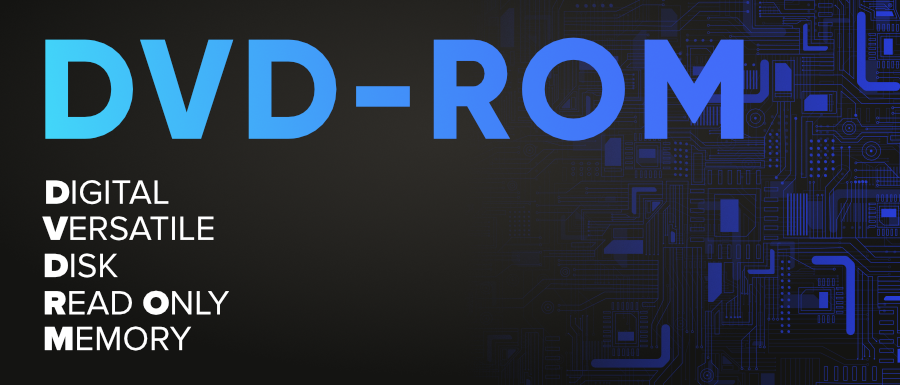DVD-ROM Full Form
Last Updated :
29 Aug, 2023
Digital data are stored on optical media, such as DVDs. Although it is the same size as a CD, it has more storage space. While some DVDs are structured exclusively for movie playback, others could contain various forms of data, including computer files and software programs. There are three main types of DVDs. DVD-ROM, DVD-R, DVD-RW.
What is DVD-ROM?
DVD-ROM stands for Digital Versatile Disk-Read Only Memory. A read-only DVD is used to store the files permanently which cannot be changed, write-over, or erased. We can use DVD-ROM for the allotment of large applications which increase the size of a CD-ROM disc. The DVD-ROM was introduced by a group of ten international companies in 1996 developing DVD and HD-DVD formats for media, software, and hardware.

Through DVD-RAM and DVD-ROM drives, we can read easily in computers, but typically not in DVD drives connect with the TVs and home theater systems. We can store around 4.38 GB of data in DVD-ROM, but CD-ROM only stores 650 MB of data. A typical DVD-ROM can hold up to 17 GB/s of data if both sides of the disc are writable.
Characteristics of DVD-ROM
- The discs which are prerecorded using molding machines that physically stamp data onto the DVD. A such disc is a form of DVD-ROM because data can only in the read form and not written or erased. Some examples of rewritable DVDs are DVD-RW, DVD+RW, and DVD-RAM.
- Capacity: 4.7 GB (single-sided, single-layer – common) 8.5 GB (single-sided, double-layer) 9.4 GB (double-sided, single-layer) 17.08 GB (double-sided, double-layer).
- DVD-ROM basically are of two types. one is blank and other contains data. Each disc is 0.6 mm thick, and are combined together to form a DVD disc. The process of combining the two-disc together must be done carefully to make the disc as flat as possible to avoid ‘disc-tilt’.
- DVD-ROM can be recordable and rewritable both. Recordable DVD discs supporting dual-layer technology are backward-compatible with some hardware developed before the recordable medium.
- If we compare DVD-ROM to CD-ROM, has the same diameter is 5 inch and 1.2 mm thickness but a DVD-ROM uses a shorter wavelength laser with tighter compacted pits, the disc capacity increased. The minimum size of DVD-ROM stores approximately 7 times more data than CD-ROM.
Advantages of DVD-ROM
- Sharing Data and Files: the one who is not in the local network then we have so many several ways to transfer the files. A DVD-ROM can be used to transfer the files to anyone. Because DVDs give us more space than a CD-ROM disc.
- Restore/Back-up: A DVD provides a large storage where we can back up the important information and applications. Any computer user knows the importance of backup who has suffered. We can save the entire image using the software e.g., Norton’s Ghost to back up the whole drive.
- Affordable cost per gigabyte: If we talk about the cost of DVDs per gigabyte then DVDs have an advantage, we can buy the set of blank DVDs from anywhere. These are the most significant savings as compared to flash drives, etc.
Disadvantages of DVD-ROM
- Rewriting: DVD-ROM is a poor choice when you are storing data for an ongoing project that you’ll need to change on a regular basis. DVD is good to use when we don’t need to change the data on a regular basis.
- Compatibility issue: We can face issues with some programs with the drive since DVD-ROM is a relatively new technology for example, Real Jukebox, some music management software program, may not work with some drives.
- Resistless: DVDs are vulnerable to scratching, breaking, and wrapping when stored improperly. Damage to your DVD can mean partial or even total data loss.
- Expensive: It is more expensive than DVD-RAM and many other DVD and CD disks.
DVD ROM – FAQs
1. How much data can a DVD-ROM store?
Disks with capacities ranging from 4.7GB to 17GB and access rates ranging from 600 KBps to 1.3 MBps are supported by the DVD-ROM specification. About seven times as much data as a CD-ROM may be stored on the smallest DVD-ROM.
2. What is a DVD-ROM used for?
For distribution of huge applications that increase the size of a CD-ROM disc, we can use DVD-ROM. Both recording and rewriting are possible on DVD-ROM. A DVD-ROM can be used to transfer the files or software to anyone.
3. What is the difference between CD-ROM and DVD-ROM?
It has the same functionality as a CD-ROM but a bigger storage space. About 4.38 GB of data are stored on a DVD-ROM. 650 MB of data are typically stored on a CD-ROM. A DVD-ROM shares the same 5-inch diameter and 1.2 millimeter (mm) thickness as a CD-ROM.
Like Article
Suggest improvement
Share your thoughts in the comments
Please Login to comment...